#Dr Shoury Kuttappa
Explore tagged Tumblr posts
Text
EFFECTIVE FORMAL MENTORING: PROVEN STRATEGIES AND BENEFITS - A PERSPECTIVE – CHAPTER -02
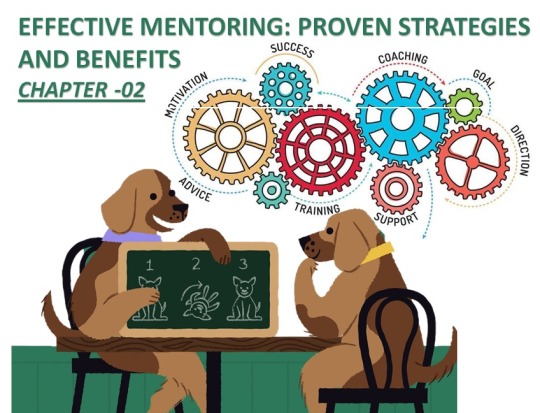
***Continued from Chapter 01 (Importance of Mentoring, Constructing Reciprocal Relationships, Definitions Of Coaching, Consulting, Mentoring And Training, Challenges in Creating a Mentoring Program)
Link to Chapter 01:
Impressive Corporate Mentorship Programs That Worked
The most recognizable organizations in the world see mentorship as a competitive advantage. Corporate Mentorship Programs prove the power of investing in employee development. Mentorship Programs Come in All Shapes & Sizes, and there may not be a one-size-fits-all model. That doesn't mean we need decades of experience to build the program that's right for us. The most effective leaders tailor their programs around 4 basic components: participants, style, format, and purpose.

Some interesting examples of Stellar Corporate Mentorship Programs may be as follows:
A) Boeing: . . . .

Program Focus: Career and Leadership Mentoring
Program Description: After extensive research, Boeing established formal best practices to drive program success across their organization. Programs operate under strict parameters and defined goals. Programs even feature orientation sessions where program participants develop the skills necessary to maintain mutually beneficial relationships.
In Boeing’s Rotational Program interns and new employees partner with senior managers and executives to set career goals and plans across business, engineering, HR, and IT departments.
Boeing believes that diversity is essential for success and their 1-to-1 Learning Program backs that up. Peers from a wide range of backgrounds meet 1-to-1 to expand their perspectives and learn the skills they need to succeed in a global workforce.
At the Boeing Leadership Center, future leaders are partnered with current leadership to learn the interpersonal skills they will need to help all employees reach their full potential.
B) Caterpillar: . . . .
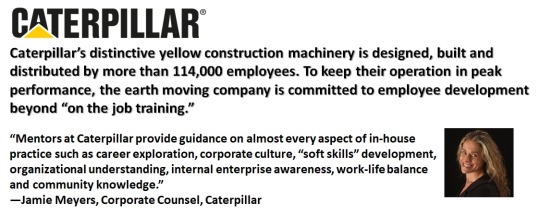
Program Focus: Career Mentoring
Program Description: Caterpillar places an intense focus on development for interns and young employees. Over the course of two to three years, program participants work to develop core skills in their focus area. Through deep personal relationships with executives and senior management, mentees also get the chance to develop advanced leadership skills. Whether employees are interested in leadership, technical development, engineering or HR, there is a program for each. Employees can learn more on their mentorship site and careers pages too.
C) McGraw-Hill: . . . .
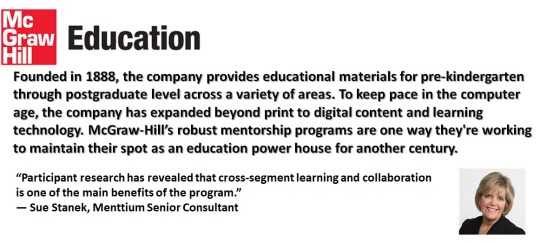
Program Focus: Broaden Perspective and Leadership Development
Program Description: To broaden perspectives across more than 20,000 employees in 38 countries, McGraw-Hill draws from a variety of business units and countries to form the core of their mentorship program. Like Boeing, McGraw-Hill knew that program success for such a large organization would come down to execution. To make sure the program produced results, McGraw-Hill's Women's Initiative for Networking and Success conduct extensive research to develop formal best practices.
McGraw-Hill partnered with Menttium Corporation to ensure a flawless execution. Consultants partnered with senior leadership to define goals around leadership development, thought leadership, broadening perspectives, and more.
D) Sodexo: . . . .
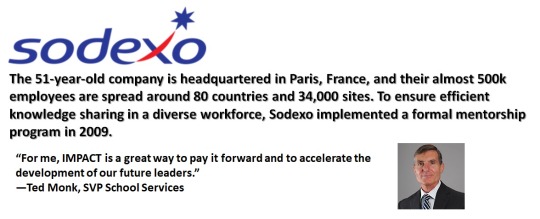
Program Focus: Career Mentoring
Program Description: Offered to all employees in the U.S., Sodexo’s three-part Spirit of Mentoring program is built to facilitate knowledge transfer and career development.
Sodexo describes the program as "an opportunity to help one another develop through collaboration, goal achievement and problem solving." They go on to say that "mentoring is a developmental partnership through which partners share perspectives as they foster personal and professional growth."
In the IMPACT program, long-lasting partnerships are forged where mentor and mentee develop relationships that continue past the formal end of their program. During the informal Bridge and Peer-to-Peer Programs, frontline managers and new hires come together to share best practices, development opportunities and to spread diversity through the management level.
E) Zynga: . . . .
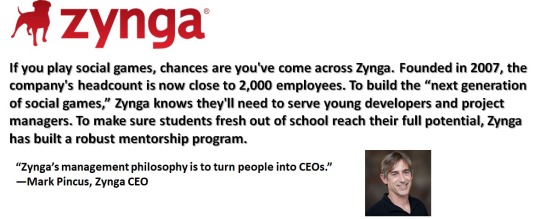
Program Focus: Career Development
Program Description: Recent graduates start with a one-week intensive program designed to get new employees up to speed. Over the next six months, employees are exposed to a variety of focus areas. Once participants graduate from the program they get the chance to make important decisions about which team they'll join.
Students within two years of graduating can participate in Zynga's internship program. During the program interns receive all the benefits of full-time employees while they explore personal projects and build their professional networks.
A Mentor’s Toolkit
More often than not, a mentee will not be somebody that we work with directly. What this means is that we don't have full context around decisions being made in their company or by them, so we really can't critique them or give feedback as we would for somebody that we are directly managing. As a mentor, we have three basic tools in our belt to help the mentee:
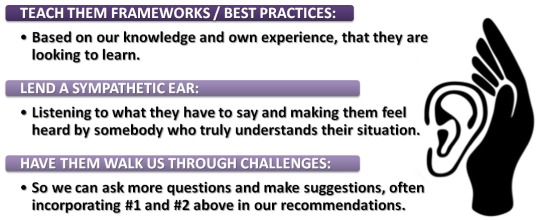
For example, if the mentee is having trouble with stakeholder management, have them talk about a specific recent example. If they’re having trouble with roadmap management, have them show how they manage the roadmap today and explain the challenges they’re having. We can then ask lots of questions to gain enough context to make suggestions.
Common mistakes in Mentoring: . . . It is possible to note a high increase in productivity and teamwork as a result of a properly structured mentoring process. Though, when referring to mentoring, we may remember the possible shortcomings and peculiarities of the mentoring process. In the process of mentoring, situations can arise that lead the whole process to unexpected results without any benefits. The most common mistakes are:
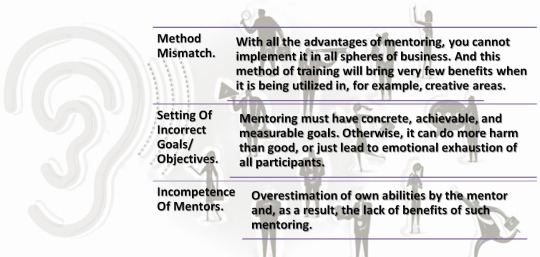

Content Curated By: Dr Shoury Kuttappa

#socialintelligence#emotionalintelligence#behaviours#coaching#decisionmaking#gratitude#relationships#ReciprocalMentoring#FormalMentoring#CareerGrowth#LeadershipDevelopment#MentorshipGoals#Mentoring#Leadership#SkillDevelopment#CareerMentorship#dr shoury kuttappa
0 notes
Text
Closing the Gap: Bridging the Transition from School to University

The event "Closing the Gap: Bridging the Transition from School to University," organized by Mindler, a leading educational services company, was highly successful and well received.
Dr. Shoury Kuttappa, Academic Manager and Counsellor from Amrita Vishwa Vidyapeetham, captivated attendees with his expertise on supporting students through this pivotal transition. His presentation offered invaluable strategies for handling university admissions, academic demands, and career planning, addressing the key concerns of students and parents alike.
The collaboration between Mindler and Suncity School in Gurugram provided an ideal platform to foster academic readiness, ensuring students and families felt informed and prepared for the next step in their educational journey.
#EducationConclave#SchoolToUniversity#StudentTransition#HigherEducation#FutureLeaders#CareerGuidance#UniversityAdmissions#DrShouryKuttappa#AcademicOutreach#AmritaVishwaVidyapeetham#StudentSuccess#EducationalLeadership#BridgingTheGap#SuncitySchool#Mindler#Dr Shoury Kuttappa
0 notes
Text
SELF-REFLECTION: INITIATION

Being present with oneself, in the moment, being mindful, mentalizing, reflective function—all of these constructs point toward a crucial recognition of one’s own experience that takes place over and over again on short time scales, as much as it is an overarching way of seeing that spans a lifetime. Practicing curiosity fosters open-mindedness.
There is the “a-ha” moment of realizing what one had temporarily forgotten, an often-amusing moment of noticing that one stopped noticing something basic. Witnessing one’s own witnessing while participating in the flow of other activities grounds one in a particular sense of security, leading toward integration as the scope of awareness becomes encompassing. There is a firm but gentle way to be intently aware, where one almost sees oneself as a beloved stranger. Being a stranger to oneself can represent alienation and nihilism, but it can also be the beginning of a love affair as we meet ourselves anew. Closeness to oneself, however, can pose a variety of real and imagined threats. It’s important to respect our own boundaries, self-consent to all major decisions, and equip ourselves well. Self-inquiry is a complex affair. There are so many layers and options, and fully cataloguing every dimension would be quite an undertaking. Taking it all in and using it implicitly would be ridiculous. In the meantime, here are a few questions and related observations, which may be handy. A) Why am I thinking this? I mean this thought, right now: . . . . .
While this can simply be a curious question, it may feel critical particularly if the emotional tone (the inner tone of voice) is short or explicitly berating. However, there is a possibility that this is a useful question, as it allows one to trace back the origins or triggers of a particular train of thought or sequence of experiences. “How come” or “when did you first notice this” can be other ways to wonder why. B) What is happening? This is what is passing through my mind: . . . . . . This feels like recognition, though the content may change. There is a sense of sureness, no doubt. It may be a fleeting notion, or an old familiar companion. Getting such repeating complexes of thought-emotion-behaviour, holistic experience, is useful. They may represent the brain’s resting state network, or default mode network (DMN) activity. Many people do not pay attention to this background noise, but it isn’t fully random. There are often large parts which are consistent over time. Whether they work as we wish, and so on, is another question. C) What am I seeing? More to the point, where is attention focused?: . . . . . . A lot of how we think is in a visual mode. The mind is a high-entropy system, meaning it can be in many possible states. According to physicist Emerson M. Pugh (though often ascribed to others), “If the human brain were so simple that we could understand it, we would be so simple that we couldn’t.” We can imagine anything, given enough time, but the reality is that at any given moment we have a limited capacity to hold information in mind. This is the paradox of the brain, which is effectively infinite to itself while being severely constrained, as in theory I can think, say or experience a massive number of possible things. In the visual metaphor, we can control how far away we are from the object of attention, creating a degree of detachment without disengagement. D) Am I listening? Did I stop listening to what is important to me?: . . . . . Listening is key because we can expand the soundscape of how we take our own thoughts. Sometimes the littlest voices are the most important, as is often said. The default mode network is meant to meander, and meandering is healthy, creative, and restorative. It lets us stumble upon interesting and potentially important things we might otherwise zip past. The executive control network can remember what was prioritized, execute plans, and direct resources. The salience network decides what to highlight and what to filter out, to a significant extent based on past experiences, for better or worse. Clearing the mind makes listening easier. E) Am I using all my senses? . . . . . . Other ways of self-attention track with other sensory modalities, scent or olfaction, touch, taste, body sense or proprioception, and subtle cues of a very basic nature, such as level of tension and groundness, feeling uprooted or firmly planted. It takes a bit of a Sherlock Holmes mentality to fully get a sense of oneself first by looking for all the tell-tale clues. Any sense can be a metaphor or template for ways of inner perception. The immersion in digital reality tends to make it harder to cultivate other senses, though, as audio-visual systems get disproportionately used, and highly developed. Adaptations to cyber-reality may make it harder to be present in an embodied form, as we come to expect and have become accustomed to obvious simulation. It also changes the way we relate to one another. F) Am I present? . . . . . The act of asking this question, which may be dispassionate and compassionate, can have the immediate effect of returning one to the present. This is especially true if the path is well-travelled. Neurotic tendencies interfere, with second-guessing and worry. It’s like building a bridge into the air over a canyon without being able to see the other side. Being present uses up mental resources, taking other brain systems offline, such as those involved in excessive worry. It also means that we can’t think about the past and future in quite the same ways, as there is a sense of time standing still in the present moment. Long-term planning from this perspective is more of a blueprint, perhaps as imperfectly glimpsed in a dream. There is a question of whether humanity has been sleepwalking — a manifestation of collective self-hypnotic somnambulism — and whether we are becoming woke, or not. Being present allows us to at least take stock of our personal inventory, possibly catching more of what we ordinarily downplay or completely miss.
Sometimes we have an idea, and while we are thinking about it, we realize we are struggling to clarify to ourself what we are really thinking. We have an idea and wanted to communicate it to someone else, but find ourselves saying, “it’s hard to explain”. Some questions that may help us out of this are:
Clarity: . . . . . . . . . . . . Can we illustrate what we mean? Could we give an example in a visual format?
Accuracy: . . . . . . . . . . . . How could we verify or test it? Can we check it some way? Do we need or want to do this?
Precision: : . . . . . . . . . . . .Could we be more specific? Can we give a clearer more detailed version of this idea?
Relevance: . . . . . . . . . . . .How does that solve a problem? How does it bear on a question?
Depth: . . . . . . . . . . . . What are some of the complexities with this idea? What factors make this a difficult problem?
Breadth: . . . . . . . . . . . . Should we consider another point of view? What is the other perspective?
Logic: . . . . . . . . . . . . Does this make sense? Does it need to make sense? Is this abstract? If so, can we explain it in a way others will understand?
Significance: . . . . . . . . . . . . Is this the most important idea to consider right now? Does it line up with our priorities?
Fairness: . . . . . . . . . . . . Do we have a vested interest in this? Are we considering the feelings of others here? Is this idea self serving or not?
Content Curated By: Dr Shoury Kuttappa

#mindfulness#self image#self reflection#self inquiry#self concept#emotional intelligence#listening#focus#acceptance#awareness#emotions#thoughts#feelings#gratitude#self leadership
3 notes
·
View notes
Text
Parent Counselling Session: Building Resilient Mindsets for Career Challenges

The recent Parent Counselling Session, "Building Resilient Mindsets for Career Challenges," led by Dr. Shoury Kuttappa, was a remarkable success, drawing positive feedback from parents seeking to support their children’s career journeys.
Dr. Shoury Kuttappa, known for his deep expertise in academic counseling and career development, provided insightful strategies to help parents cultivate resilience and adaptability in their children. His engaging approach highlighted the value of a growth mindset, teaching parents how to encourage perseverance and confidence in students facing the evolving demands of today’s job market.
The session also emphasized how a resilient mindset can empower students to navigate career challenges with clarity and purpose, making it highly impactful and beneficial for the audience.
#future of education#indian education#professional development#emotional intelligence#school leadership#life skills#Dr Shoury Kuttappa#parenting#career guidance#career development#growth mindset
0 notes
Text
Augmenting Emotional Intelligence

The "Augmenting Emotional Intelligence" webinar, featuring Dr. Shoury Kuttappa as a key panelist, was a significant achievement, drawing in an engaged audience of students, educators, and professionals.
Held by Amrita Vishwa Vidyapeetham, the session emphasized the importance of emotional intelligence in education and career growth. Dr. Shoury Kuttappa’s expert insights into building emotional resilience and leadership skills resonated with attendees, who commended the event for its practical strategies and inspiring guidance. This successful event underscored the value of emotional intelligence in achieving both academic and personal success.
#empowering teachers#future of education#indian education#professional development#growth mindset#educational leadership#quality education#education#learning#higher education#Dr Shoury Kuttappa
0 notes
Text
Time Management During Board Exams

The "Time Management During Board Exams" webinar, hosted by Amrita Vishwa Vidyapeetham and led by Dr. Shoury Kuttappa, was welcomed enthusiastically. The session attracted high school students, educators, and parents seeking practical advice on how to enhance productivity and manage study schedules effectively during the critical board exam period.
Dr. Shoury Kuttappa, an experienced academic manager and counselor, shared proven time management techniques, goal-setting strategies, and stress-reduction tips tailored for exam success. Attendees engaged actively in the interactive segments, and the post-webinar quiz, which featured exciting prizes like an Amazon Echo Dot and smartwatch, further boosted engagement.
Participants praised Dr. Shoury Kuttappa’s insightful, hands-on approach, expressing that the session left them feeling more prepared and confident for the exam season. The positive feedback on social media platforms highlighted the impact of the webinar, solidifying it as a valuable resource for students looking to excel in their exams.
#time management#exam stress#exampreparation#future of education#professional development#academic excellence#Dr Shoury Kuttappa
0 notes
Text
Experiential Learning

The recent webinar on “Experiential Learning” led by Dr. Shoury Kuttappa was a great success, drawing a large, engaged audience eager to explore innovative teaching methods.
Hosted by Kasturi Institute of Management, the event highlighted the importance of experiential learning for effective skill development and knowledge retention.
Dr. Shoury Kuttappa’s insights on "learning by doing" resonated with educators and students alike, sparking positive discussions and feedback.
Participants appreciated the interactive format and actionable strategies for implementing experiential learning, making it a valuable session on educational innovation and student engagement.
#experiential learning#learningbydoing#skilldevelopment#studentengagement#career development#Dr Shoury Kuttappa#adult learning
0 notes
Text
Should Reality Shows be Banned (Kids)

#professional development#national education policy#indian education#future of education#empowering teachers#success mindset#growth mindset#life long learning#quality education#Dr Shoury Kuttappa
0 notes
Text
Assessments and Benchmarks

#national education policy#indian education#future of education#empowering teachers#professional development#assessment#school leadership#Dr Shoury Kuttappa
0 notes
Text
Characteristics of Highly Effective Schools

#professional development#national education policy#indian education#future of education#school leadership#growth mindset#Dr Shoury Kuttappa
0 notes
Text

#future of education#indian education#professional development#datascience#data analytics#decisionmaking#Dr Shoury Kuttappa
0 notes
Text
Sustainable School Campuses

youtube
#empowering teachers#future of education#indian education#professional development#growth mindset#school leadership#transformational leadership#Dr Shoury Kuttappa#Youtube
0 notes
Text
Covid Learning Loss- Have Students Recovered Yet

#empowering teachers#indian education#future of education#professional development#career development#career guidance#Dr Shoury Kuttappa
0 notes
Text
Can We let Teens Decide their Syllabus

#indian education#future of education#professional development#empowering teachers#career guidance#career development#Dr Shoury Kuttappa
0 notes
Text

#empowering teachers#indian education#future of education#professional development#emotional intelligence#transformational leadership#school leadership#Dr Shoury Kuttappa
0 notes
Text
Master Class - Circle of influence

youtube
#empowering teachers#future of education#indian education#national education policy#professional development#growth mindset#emotional intelligence#school leadership#Dr Shoury Kuttappa#Youtube
0 notes